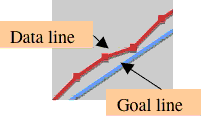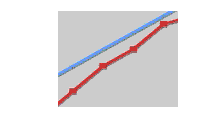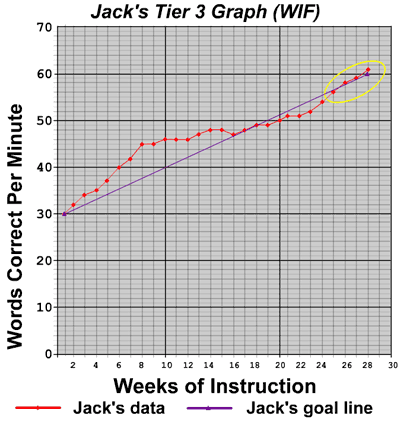How can the Rosa Parks teachers effectively implement the RTI components in each tier?
Page 7: Tier 3
After evaluating the slope and performance level for each student receiving Tier 2 intervention, Mr. Brewster and Ms. Washington determine that Laney has not responded adequately to the targeted intervention and would benefit from the more intensive, individualized instruction provided in Tier 3. Because Tier 3 at Rosa Parks Elementary is special education, Mr. Brewster refers Laney for a special education evaluation. This can begin once Laney’s parents have been notified and agree to it.
 Laney, along with her classmates, received a hearing and vision screening from the school nurse at the beginning of the school year. Soon, Mr. Johnson, the school psychologist, meets with Laney to begin an abbreviated psychoeducational evaluation. He administers an intelligence test and adaptive behavior scales, and he interprets the behavior checklists completed by Mr. Brewster and by Laney’s parents. Laney will also meet with the speech and language therapist for an evaluation.
Laney, along with her classmates, received a hearing and vision screening from the school nurse at the beginning of the school year. Soon, Mr. Johnson, the school psychologist, meets with Laney to begin an abbreviated psychoeducational evaluation. He administers an intelligence test and adaptive behavior scales, and he interprets the behavior checklists completed by Mr. Brewster and by Laney’s parents. Laney will also meet with the speech and language therapist for an evaluation.
psychoeducational evaluation
An evaluative measure that usually includes intelligence testing, achievement testing, and an assessment of adaptive behavior skills for the purpose of designing an educational program appropriate to the needs of the student.
Abbreviated Evaluation Checklist
- Hearing screening
- Vision screening
- Intelligence test
- Adaptive behavior scales
- Speech and language evaluation
- Behavior checklist – parent
- Behavior checklist – teacher
 Laney’s beginning-of-the-year vision and hearing screenings were normal. The results of the recent intelligence test and adaptive behavior scales indicate that Laney has average intellectual ability, ruling out an intellectual disability as the reason for her struggles with reading. The results of the behavior checklist indicate that Laney’s behavior is within normal limits, ruling out an emotional or behavior disorder as the reason for her inadequate reading progress. In accordance with IDEA ’04, environmental, cultural, and economic disadvantages are also ruled out as causes of Laney’s reading difficulties. The speech and language evaluation indicates that Laney has a mild language impairment. The IEP team reviews Mr. Johnson’s report and Laney’s progress monitoring data and determines that Laney has a learning disability and therefore qualifies for special education services. Additionally, the team determines that Laney will benefit from speech and language services provided through special education related services.
Laney’s beginning-of-the-year vision and hearing screenings were normal. The results of the recent intelligence test and adaptive behavior scales indicate that Laney has average intellectual ability, ruling out an intellectual disability as the reason for her struggles with reading. The results of the behavior checklist indicate that Laney’s behavior is within normal limits, ruling out an emotional or behavior disorder as the reason for her inadequate reading progress. In accordance with IDEA ’04, environmental, cultural, and economic disadvantages are also ruled out as causes of Laney’s reading difficulties. The speech and language evaluation indicates that Laney has a mild language impairment. The IEP team reviews Mr. Johnson’s report and Laney’s progress monitoring data and determines that Laney has a learning disability and therefore qualifies for special education services. Additionally, the team determines that Laney will benefit from speech and language services provided through special education related services.
 Laney, along with Jack, will now join Ms. Jacobs—one of the special education teachers at Rosa Parks—for 45 minutes each day of more intensive, individualized intervention. Mr. Brewster will plan for them to be out of his class from 12:15-1:00 each day. In order for Laney and Jack to participate in social studies, Mr. Brewster will alternate the order in which he teaches science and social studies each day. For example, Mr. Brewster will provide instruction for social studies from 12:00–12:30 on Tuesdays and Thursdays.
Laney, along with Jack, will now join Ms. Jacobs—one of the special education teachers at Rosa Parks—for 45 minutes each day of more intensive, individualized intervention. Mr. Brewster will plan for them to be out of his class from 12:15-1:00 each day. In order for Laney and Jack to participate in social studies, Mr. Brewster will alternate the order in which he teaches science and social studies each day. For example, Mr. Brewster will provide instruction for social studies from 12:00–12:30 on Tuesdays and Thursdays.
| Mr. Brewster | ||
| 12:00 – 12:30 | Science (M, W, F) Social Studies (T, Th) |
|
| 12:30 – 1:00 | Social Studies (M, W, F) Science (T, Th) |
|
12:15 – 1:00 Tier 3 intervention
Providing 40–60 Additional Minutes of High-Quality Instruction

Ms. Jacobs will provide 45 minutes of intensive, individualized instruction to Laney and Jack. She will continue to cover the five core reading components by using validated instructional strategies that meet each student’s specific needs. For this reason, the group size is limited to no more than three students. The components taught will depend on the students’ skill levels versus grade levels.
| Reading Component | Kindergarten | First Grade | Second Grade | Third Grade |
| Phonemic Awareness | ||||
| Phonics and Word Study | ||||
| Fluency | ||||
| Vocabulary | ||||
| Reading Comprehension |
National Reading Panel, 2000; Texas Essential Knowledge and Skills (TEKS)

Tier 3 is different from Tier 2 because instruction is:
- Focused on individualized goals, which may or may not be on grade level
- Individualized based on each student’s progress monitoring data
- More intense, often through longer or more frequent sessions and through smaller group sizes
For more information on high-quality reading instruction in Tier 3, view the following IRIS Module:
For Your Information
Tier 3 intervention is typically delivered outside the general education classroom by someone who specializes in providing and designing individualized interventions. This intervention may or may not be provided through special education services. When Tier 3 is provided as part of general education, qualified instructors may include the special education teacher or another highly trained individual, such as a reading specialist, depending on the district’s or the school’s resources.
Progress Monitoring
Ms. Jacobs will continue to monitor Jack’s and Laney’s progress. She will administer the WIF to Jack and the PRF to Laney. Jack will receive the WIF because his skills are far below grade level, whereas Laney will receive the PRF because her reading skills are stronger than Jack’s. Ms. Jacobs will continue to plot each student’s scores on his or her existing progress monitoring graph, and she will meet regularly with Mr. Brewster to discuss the students’ progress.
Making Instructional Decisions
 Ms. Jacobs will use the progress monitoring data to determine whether she needs to make an instructional change for each student. She will do this by examining the relationship between the four most recent data points and the goal line on each student’s graph. Ms. Jacobs will use the information in the table below to determine the instructional decision she needs to make for each student.
Ms. Jacobs will use the progress monitoring data to determine whether she needs to make an instructional change for each student. She will do this by examining the relationship between the four most recent data points and the goal line on each student’s graph. Ms. Jacobs will use the information in the table below to determine the instructional decision she needs to make for each student.
Goal line
The goal line connects a student’s initial progress monitoring scores to an expected short-term goal or benchmark.
| Position of the 4 Most Recent Data Points | Instructional Decision |
Above the goal line… |
Increase the goal: If the points are mostly higher than the goal line, the student’s performance is exceeding expectations and a slightly more ambitious goal is needed. |
Below the goal line… |
Change instruction: Something is not working. Try a different instructional approach and continue to collect data to see if it helps. |
Around the goal line… |
Make no changes: The method appears to be working because the student is on target to meet the end-of-year goal. |
Ms. Jacobs begins collecting progress monitoring data for Jack and Laney twice per week to guide her instructional decision-making and to track each student’s progress toward meeting his or her individualized goal. She also plans to use the data to determine whether each student should exit Tier 3.

This is a line plot graph of Jack’s Tier 3 data. The x-axis is labeled “Weeks of Instruction.” Weeks 0 through 30 are shown, with every two weeks labeled on the axis. The y-axis is labeled “Words Correct Per Minute.” 0 to 70 correct words per minute are shown, with every 10 words correct per minute labeled on the axis. There are two line plot graphs during this Tier 3 instruction. The red graph shows Jack’s data and the purple graph shows Jack’s goal line. These graph indications are shown in the key underneath the graph. Jack’s goal line begins at 30 words correct per minute and stretches to 60 words correct per minute by Week 28. Jack’s data points fall above the goal line from week 2 through 16, then hover on the goal line through 18. His data points fall below the goal line from week 18 through 25, and then hover on the goal line for the last four weeks and move slightly above the goal line during the last week, week 28. The last four data points are circled in yellow, indicating that Jack’s teacher, Ms. Jacobs is noticing his most recent data is around the goal line and she, therefore, does not need to make changes to her instruction for Jack.
After a few weeks, Ms. Jacobs examines Jack’s data. She notices that his last four data points are around the goal line. Therefore, Ms. Jacobs will make no changes to his instruction.
Activity
It’s your turn. Help Ms. Jacobs to evaluate Laney’s progress to determine whether she needs to make instructional changes. Click on Laney’s picture to begin this activity.
